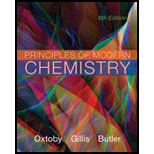
Concept explainers
a)
Interpretation: The ionization energy of molecular hydrogen is greater than atomic hydrogen should be explained. Also, the ionization energy of molecular oxygen is lower than atomic oxygen should be explained.
Concept introduction: Two or more than two atomic orbitals overlap to form bond, these orbitals are called molecular orbitals. Count of molecular orbital obtained is same as count of atomic orbitals mixed.
Two forms of molecular orbital are obtained. These are bonding and antibonding orbital.
Bonding orbitals are those in that electrons are in between nucleus of two atom. Antibonding orbitals are those in which electrons are away from nucleus of two-atom. Also, electrons in antibonding orbital have energy high as compared to bonding orbital.
In sigma
In pi
In pi
b)
Interpretation: The relative ionization energies of atomic and molecular fluorine should be determined.
Concept introduction: Two or more than two atomic orbitals overlap to form bond, these orbitals are called molecular orbitals. Count of molecular orbital obtained is same as count of atomic orbitals mixed.
Two forms of molecular orbital are obtained. These are bonding and antibonding orbital.
Bonding orbitals are those in that electrons are in between nucleus of two atom. Antibonding orbitals are those in which electrons are away from nucleus of two-atom. Also, electrons in antibonding orbital have energy high as compared to bonding orbital.
In sigma
In pi
In pi
Want to see the full answer?
Check out a sample textbook solution
Chapter 6 Solutions
Bundle: Principles of Modern Chemistry, 8th + OWLv2, 1 term (6 months) Printed Access Card
- Assign the functional group bands on the IR spectra.arrow_forwardFind the pH of a 0.120 M solution of HNO2. Find the pH ignoring activity effects (i.e., the normal way). Find the pH in a solution of 0.050 M NaCl, including activityarrow_forwardPlease help me answer these three questions. Required info should be in data table.arrow_forward
- Draw the major organic substitution product or products for (2R,3S)-2-bromo-3-methylpentane reacting with the given nucleophile. Clearly drawn the stereochemistry, including a wedged bond, a dashed bond and two in-plane bonds at each stereogenic center. Omit any byproducts. Bri CH3CH2O- (conc.) Draw the major organic product or products.arrow_forwardTartaric acid (C4H6O6) is a diprotic weak acid. A sample of 875 mg tartaric acid are dissolved in 100 mL water and titrated with 0.994 M NaOH. How many mL of NaOH are needed to reach the first equivalence point? How many mL of NaOH are needed to reach the second equivalence point?arrow_forwardIncluding activity, calculate the solubility of Pb(IO3)2 in a matrix of 0.020 M Mg(NO3)2.arrow_forward
- Order the following series of compounds from highest to lowest reactivity to electrophilic aromatic substitution, explaining your answer: 2-nitrophenol, p-Toluidine, N-(4-methylphenyl)acetamide, 4-methylbenzonitrile, 4-(trifluoromethyl)benzonitrile.arrow_forwardOrdene la siguiente serie de compuestos de mayor a menor reactividad a la sustitución aromática electrofílica, explicando su respuesta: ácido bencenosulfónico, fluorobenceno, etilbenceno, clorobenceno, terc-butilbenceno, acetofenona.arrow_forwardCan I please get all final concentrations please!arrow_forward
 Chemistry & Chemical ReactivityChemistryISBN:9781337399074Author:John C. Kotz, Paul M. Treichel, John Townsend, David TreichelPublisher:Cengage Learning
Chemistry & Chemical ReactivityChemistryISBN:9781337399074Author:John C. Kotz, Paul M. Treichel, John Townsend, David TreichelPublisher:Cengage Learning
